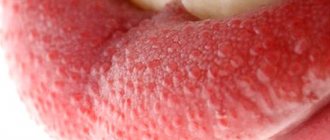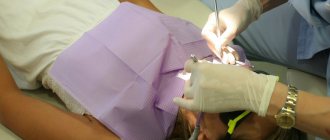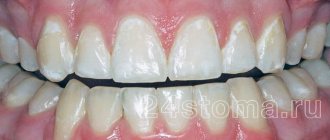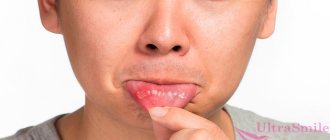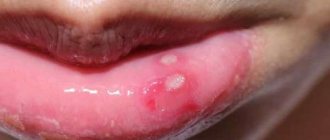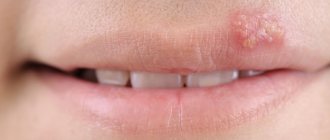July 28, 2020
Some parents, upon discovering a white dot on the gum of an infant or older child, immediately begin to panic. Taking care of your baby's health is the right thing to do, but a symptom is not always a threat. In any case, you first need to figure out what triggered the appearance of a spot, pimple or lump, and then act, but, of course, without unnecessary nerves and preferably by consulting a doctor. And journalists from the UltraSmile.ru portal will tell you about the main reasons why white spots might appear on your baby’s gums.
Reason No. 1. Epstein's pearls, or palatal cysts
White spots on a newborn's gums can be completely harmless if they are Epstein pearls. They are usually located on the upper jaw and palate. Outwardly they look like yellowish or white beads. Size – no more than 3 mm in diameter. They appear in 60–85% of newborns. They are nothing more than a cluster of epithelial cells. The formations are noticeable when yawning and opening the mouth. They do not cause babies any unpleasant sensations or discomfort, and 1–2 weeks after birth they go away on their own.
Epstein's pearls appear in 60–85% of newborns
“A white spot on a baby’s gum or spots that appear during the first days after birth are often caused by the accumulation of estrogen, a hormonal crisis and the body’s adaptation to new conditions. This phenomenon certainly requires careful monitoring, but does not require treatment and should not cause serious concern on the part of parents. If the baby develops normally, then during the first months of life the spots disappear on their own,” explains pediatrician A.V. Skromnova.
Causes of white plaque on gums
Candidiasis
The most likely cause of such symptoms is infection with microscopic fungi of the genus Candida, relatives of common culinary yeast. Candida is an opportunistic organism that is present in the microflora of healthy people and animals. However, if the concentration of the fungus on the surface of the mucous membranes exceeds a certain critical threshold, its vital activity leads to the appearance of a number of unpleasant symptoms. One of the main manifestations of candidiasis is the formation of a white coating, which can cover both small and large areas of mucous membranes. This plaque consists of fibrin, bacterial mass, waste products of microorganisms, and pseudomycelium of the fungus Candida. When it is scraped off, areas of ulceration and maceration (softening) of the mucosa are revealed.
A white spot on the gum is not the only manifestation of this disease; the fungus can also affect the mucous membranes of the palate, the inside of the cheeks, the tongue, the corners of the lips, and the bottom of the mouth. In addition, candidiasis is often accompanied by the appearance of such unpleasant symptoms as burning, dryness, and soreness in the mouth; Systemic signs of infection may also occur - fever, nausea, headaches, general weakness and malaise.
Treatment and prevention of candidiasis include the use of antifungal and antiseptic drugs, agents that accelerate the regeneration of damaged epithelium. Good results are achieved by regular use of rinses with disinfecting components - for example, chlorhexidine and benzydamine, which are part of the ASEPTA rinse, are active against a wide range of pathogens. The use of such remedies helps get rid of inflammation and bleeding, reduce the risk of developing a secondary infection and speed up recovery.
Leukoplakia
If the gums turn white in an adult, especially a smoker, this may be a sign of leukoplakia. Leukoplakia is not a disease in the literal sense of the word - it is only a pathological condition, which, however, often precedes the development of cancer. As a rule, this condition occurs as a result of constant exposure of the mucous membranes to one or another irritant - chemical, mechanical, temperature. As a result, hyperkeratosis occurs - keratinization of the upper layer of the mucous membrane. The appearance of white plaque is one of the signs of hyperkeratosis. Leukoplakia plaque is difficult to scrape off even with considerable effort.
Leukoplakia can be caused by exposure to chemicals contained in tobacco, the atmosphere, liquids or food, irritation of the mucous membrane due to contact with the sharp edge of a tooth or denture, too cold or hot food, galvanic current in the mouth due to the presence of metal fillings. Such processes occur in the mouth when it contains dentures containing various metals.
Treatment consists primarily of eliminating traumatic factors. Patients are also advised to use agents that accelerate tissue regeneration. One of these products is ASEPTA gel with propolis. Its regular use helps reduce itching and pain symptoms and quickly restore damaged mucous membranes.
Stomatitis
A white spot on the gum may be a sign of stomatitis, an inflammatory disease of the oral cavity. This spot is caused by the activity of one or another pathogenic microorganism. Most often, stomatitis manifests itself in the form of small white dots or spots, which over time can degenerate into ulcers. It is easy to cope with this disease at the initial stage: often it is enough to use antiseptic rinses and special medicinal gels.
For this purpose, we recommend using ASEPTA and ASEPTA Fresh rinses. They contain broad-spectrum antibacterial components, as well as substances that help eliminate inflammation, bleeding and other unpleasant symptoms of stomatitis. No less effective is the adhesive balm ASEPTA, which has a long-lasting effect on the affected areas of the mucous membranes. ASEPTA balm is also excellent for the treatment of other inflammatory diseases, periodontitis and gingivitis, which in some cases can also lead to the formation of white spots and spots.
Neoplasms
If a white spot on the gum hurts when pressed, it may be a sign of neoplasms such as a cyst or wen. In most cases, these formations do not pose a serious health hazard, but sometimes they have to be removed surgically. In children, there are also Bohn's nodes and Epstein's pearls - small cysts formed from the remains of the salivary glands, dental plates, and various epithelial inclusions. They most often do not cause unpleasant symptoms and go away on their own without special treatment.
Reason No. 2. Bon's knots
White dots on the gums of a baby, as in the photo below, are Bon's nodules. A person who is not related to medicine is unlikely to be able to distinguish them from Epstein’s pearls outwardly, especially since they also consist of keratinized epithelium, but they take longer to disappear - within 3 months after birth. Benign and completely painless nodules got their name in honor of the famous German pediatrician who first described this phenomenon back in 1886.
Bohn's nodules consist of keratinized epithelium
Reason #3: Neonatal teeth
This is a very rare phenomenon (occurs in 1–2% of cases), but it still occurs. Neonatal, or congenital, teeth appear as white balls on a baby's gums. They may appear immediately or a month after birth. Most often they are localized on the lower jaw in the incisor area.
What does a neonatal tooth look like? The white hard point on the gum of a baby resembles a regular milk unit in appearance, but it is distinguished by mobility, since its roots are too short or absent.
A white hard spot or swelling on the gum of a child who is already 4-6 months old may indicate the imminent eruption of the first milk units. Usually during this period the baby becomes restless and may develop a cough and nasal discharge. If the formation on the gum has a bluish tint, and the tooth does not break out for a long time, then this situation may indicate an eruption cyst in which blood and fluid have accumulated. Contact a doctor who will cut the gum and help the milk unit come out quickly.
Doctors recognize the phenomenon as a deviation from the norm, which is random in nature. Less commonly, the appearance of neonatal and congenital teeth is associated with developmental defects. However, there is no rush to remove such elements, since as a result they are often included in a number of milk units, of which in total the baby erupts only 20 pieces.
This pathology is very rare
But sometimes neonatal teeth are supernumerary, interfere with the baby’s eating, cause pain for the mother when breastfeeding, and in these cases they are removed. An indication for removal can also be severe mobility of the unit, because if a tooth falls out on its own, it can lead to aspiration and respiratory arrest in the baby.
Reason No. 4. Stomatitis
Often, a white pimple on a baby’s gum, as in the photo, gives reason to suspect a disease such as stomatitis. An inflammatory process on the mucous membrane can appear in both very young children and older ones. The main causes of the pathology: weak or unformed immunity, poor oral hygiene, injuries, allergies, infection of wounds and scratches in the mouth with dirty hands and foreign objects.
White dots may indicate stomatitis
A white spot on a baby’s gum, covered with plaque, most often indicates candidal stomatitis (in 90% of cases) caused by the Candida fungus, but aphthous, traumatic, drug-induced or herpes stomatitis can also be to blame. A dentist or pediatrician can determine what type of disease your child has and prescribe the appropriate course of treatment.
What is thrush
Thrush (or candidiasis) is a type of stomatitis (inflammation of the mucous membrane in the mouth) caused by a yeast-like fungus of the genus Candida. It is this fungus that causes the disease, usually transmitted through contact with an infected person.
The fungus is not a “guest” in the body: like other microorganisms, it always lives on the mucous membranes of the intestines, genitals, and mouth, but in small quantities. However, such a normal state is possible only with a “friendly” balance of “good” and “harmful” bacteria representing the microflora of the human body. This balance of equilibrium can be disrupted upon contact with a patient with thrush: in this case, a fungal infection from the outside enters the body of a healthy person and begins to multiply quickly there, disrupting the natural microflora.
This is possible when the immune system is weakened, when the number of “good” bacteria sharply decreases, and they are unable to fight the growing number of “harmful aliens.”
The occurrence of thrush in the mouth in children over the age of one year is explained by the fact that when they come into contact with each other, they pass toys and objects that they take in turn in their mouths, and among them there is often at least one child infected with candidiasis. And since the child’s immunity is still in the development stage, its internal protection is weakened, so infection occurs very quickly.
Reason No. 5. Lack of oral hygiene
White spots on a baby's gums and plaque may simply be remnants of formula or breast milk that the baby was fed with. Or indicate that the baby recently burped. How can I check this? Take a special napkin, silicone brush or cotton sponge and wipe the palate, gums and mucous membranes.
It is important to remember that even the smallest children need hygienic oral care, since their diet contains sugar, and in the mouth, just like in adults, plaque and bacteria accumulate, which can provoke an infectious and inflammatory process.
Is research necessary?
Usually, thrush in the mouth of a baby does not require additional research, since it is not difficult for an experienced specialist to diagnose it based on obvious signs. But sometimes, in case of serious lesions, additional studies may be prescribed:
- microscopic: in this case, the doctor will take scrapings from the oral mucosa to examine the yeast-like fungal cells more carefully;
- bacteriological: during such a study, a scraping is also taken and then bacteria are cultured to understand how large the volume of fungal colonies is and how amenable to treatment they are with antifungal drugs; in addition, bacteriological testing helps determine which drug is the most effective in treatment, because some of them may not have an effect in the treatment of thrush;
- serological: this study requires a blood test, in the serum of which antibodies to fungal infection are examined.
Reason No. 6. Advanced dental diseases
Of course, dental diseases in newborns are an exception. However, in children who have already acquired baby or permanent teeth, this is far from uncommon. If a child has a white dot on the gum next to the tooth as in the photo, then this may be associated with the development of periodontitis, periostitis (flux), fistula, cyst1 or abscess. These pathologies occur in cases where teeth with caries or pulpitis are not treated for a long time.
The photo shows a milk tooth cyst
Such white spots on the gums contain serous fluid or are filled with pus. They pose a serious danger to the child’s body and can lead to damage to the rudiments of permanent units, dysfunction of internal organs, blood poisoning and even death.
Possible complications
The initial stage of the disease is easy to treat.
Most often, the initial stages of diseases accompanied by the appearance of white plaque on the gums proceed unnoticed. That is why there is a problem of early diagnosis of such a disease, which can sometimes be very serious.
In an advanced stage, this symptom causes severe pain in the child, and then even the most inattentive parent will notice the problem. But treating the disease at this stage is much more difficult and longer.
In addition, in the absence of timely and correct treatment, various complications may arise:
- dysbacteriosis;
- problems with the gastrointestinal tract;
- damage to internal organs;
- transition of the disease to a chronic form;
- diseases of ENT organs;
- development of sepsis, etc.
Such complications can arise not only due to lack of treatment due to late diagnosis, but also during attempts at self-medication, when parents may mistakenly believe that they are able to cope with the disease on their own, without the help of a doctor. But in the end, this only makes the situation worse.
Reason No. 7. Wen, or lipoma
A white dot on the gum of a baby may indicate the accumulation of fatty tissue under the mucous membrane and the formation of a benign lipoma. The reasons for its appearance are varied: poor oral hygiene, trauma, past illnesses.
The neoplasm itself is not painful or dangerous, but after a long period of time it can greatly increase in size and begin to cause discomfort, be constantly injured, and even degenerate into cancer. If a baby has a wen, the doctor usually monitors its condition over time and, if necessary, may recommend removal using a laser or the traditional surgical method - with a scalpel.
A white dot on a baby's gum may be an accumulation of fatty tissue
What to do if a child has a lump, spot or dot on his gum
If you find a white spot on the gum of a baby, then you should not make a diagnosis yourself, relying on photos from the Internet, and, moreover, start self-medication. To begin with, it is recommended to thoroughly clean the mouth of a small child in order to get a good look at the growth and make sure that the problem is not caused by the accumulation of plaque and food debris. To do this, you need to use a soft silicone finger brush, specialized wipes or gauze soaked in warm water. To maintain hygiene, newborns should be given some water after each feeding.
The first step is to thoroughly clean your baby's mouth.
“If you have pimples and bumps in your mouth, run to the dentist, not to the pediatrician! Of course, there may not be anything dangerous at the points on the gums, but we have a not very pleasant situation. My daughter had a kind of pimple pop up next to a baby tooth, which looked healthy, and the pediatrician waved it off and said that it would go away on its own, but didn’t really explain anything. And the lack of intelligible explanations alarmed me, so I decided to go to the dentist. It turned out that the tooth was carious, but there was only destruction on the back side, and the pediatrician took a superficial look. I couldn’t even see it without a special mirror, normal lighting and tools! And in general, pediatricians have little education in matters of dentistry, they may not care, but your child will end up suffering!”
Gela, review from woman.ru
What if the problem is not caused by poor hygiene? Parents are advised to monitor the condition of the tumor and the well-being of the baby, and if serious pathologies are suspected and alarming symptoms appear (fever, moodiness, loss of appetite and sleep, bad breath, bleeding, etc.), they should consult a doctor. Only a specialist can make an accurate diagnosis and prescribe effective and safe treatment.
1Kushner A.N., Lapkovsky V.I., Petrovich N.I. Odontogenic cysts in children: epidemiology and treatment // Modern dentistry. – 2013.
Notice
: Undefined variable: post_id in
/home/c/ch75405/public_html/wp-content/themes/UltraSmile/single-item.php
on line
45 Notice
: Undefined variable: full in
/home/c/ch75405/public_html/wp-content /themes/UltraSmile/single-item.php
on line
46
Rate this article:
( 2 ratings, average: 5.00 out of 5)
gum disease
How to help a child at home with suppuration?
If suppuration and the formation of a lump on the gum appear, it is recommended to contact a dentist as soon as possible, but, unfortunately, for various reasons this is not always possible.
If an adult can endure pain (although, of course, situations are different), then it is much more difficult for a child to endure painful sensations, and it is not easy for parents to watch their child suffer. There are ways to alleviate the baby's condition. Naturally, they will not replace full-fledged treatment, so you can resort to them only in situations where going to the doctor is impossible right now.
These include:
- take as much warm liquid as possible, which reduces intoxication of the body;
- eat liquid food (moderately warm, but not hot!), as it injures already damaged gums;
- If the pain becomes severe, you can use painkillers. For example, Nurofen or Paracetamol - the exact dosage depends on the age of the child, so before use you should carefully read the instructions for the drug;
- to reduce swelling, you can resort to cold - any frozen product from the freezer compartment of the refrigerator is wrapped in a soft cloth and applied to the cheek;
- use rinsing solutions that temporarily relieve pain - chamomile decoction or the drug chlorhexidine, which reduces irritation.
Comments
My child has developed a white dot on his gum right next to his front baby tooth. The teeth are healthy, without holes, the child is 7 years old. What could it be?
Alexey (08/02/2020 at 00:22) Reply to comment
- Dear Alexey, perhaps your child’s permanent tooth has begun to erupt, and since the baby tooth has not yet fallen out, it simply does not have enough space and has changed the direction of growth. In this case, the baby tooth will have to be removed, otherwise there is a risk that the permanent tooth will move into the second row or will be severely curved, and the bite may be disrupted. Contact your pediatric dentist to clarify the situation and agree on a further plan of action.
Editorial staff of the portal UltraSmile.ru (08/04/2020 at 09:12) Reply to comment
I still don’t understand whether it is possible to independently treat a child if such a white spot occurs. After all, it usually goes away quickly when you spread it with brilliant green.
Alisa (08/21/2020 at 06:38) Reply to comment
Stomatitis will probably be treated in a baby with some safe ointments or pastes? Are such remedies completely safe for children or can they offer another method of treatment?
Olga (08/21/2020 at 08:56) Reply to comment
Hello, my child is 5 years old, the front tooth is much lighter than the rest, it is very noticeable (the rest of the teeth are normal white, but the front one is just snow-white.) Tell me, what is this connected with and what to do?
Vladimir (08/21/2020 at 08:58) Reply to comment
Recently we were talking to a girl on the playground and she said that her daughter often has stomatitis. I would like to know if this is contagious to other children? After all, they play with the same toys and can transmit bacteria through them.
Olga (08/21/2020 at 09:35) Reply to comment
Hello! Thanks for the useful article. After reading the article, I thought about it: my son had small dots right on his gums with a size of 0.5 mm, very small. I thought it was teething and didn’t pay much attention. The teeth are cutting through, everything is fine, thank God. I have a question: can such dots just appear before teething? Or should I also contact a pediatrician or dentist?
Kamila (08/21/2020 at 10:56 am) Reply to comment
My son has white spots on his gums and mucous membranes, has a slight fever, eats poorly, he is 1 year and 2 months old. It looks like stomatitis. Can I buy medicine for stomatitis at the pharmacy, or is it better to go to the dentist?
Olesya (08/21/2020 at 11:08 am) Reply to comment
Could white spots be an allergic reaction of the baby to spicy and salty foods in the diet of a nursing mother? The habit of generously salting and peppering food has been around for many years. For now, I’m trying to eat more neutral in taste, but sometimes I break down.
Alina (08/21/2020 at 11:26 am) Reply to comment
Why did my one-month-old baby start to have white spots on his gums, although this had never happened before? What measures would you recommend to take in this case and will these white dots harm the child?
Laima (09.23.2020 at 14:43) Reply to comment
How can white pimples on the gums and oral mucosa cause harm? These white spots have been formed for several weeks; what should the baby’s oral cavity be treated with to get rid of them?
Tanya (09.23.2020 at 14:45) Reply to comment
Tell me, can these white spots on the gums cause stomatitis in an infant? How to treat these white spots in a baby if the child is still breastfed?
Kira (09.23.2020 at 15:29) Reply to comment
The child suffers greatly due to the appearance of small white spots on the gums, as well as on the inside of the cheek. In appearance, these white dots look like leftover milk from a baby; they cannot be removed with a cotton swab; the child is constantly capricious. Please advise what can be done to rid the child of these white spots in the mouth?
Lyudmila (09.23.2020 at 15:41) Reply to comment
Write your comment Cancel reply
Prevention of white pimples in the mouth of a baby
To reduce the likelihood of acne and spots appearing in a baby’s mouth, you must adhere to the following preventive rules:
- Breastfeeding provides the baby with all the substances necessary for its full growth and development. Therefore, a nursing mother should eat well and foods that are harmful to the baby should be excluded from the diet.
- After feeding, you need to carefully clean your baby's mouth. After teething, you need to use special children's silicone brushes to clean them; as the child grows, you should teach him to maintain hygiene.
- Pacifiers and bottle nipples must be clean and washed immediately after use. Excessively long use of pacifiers negatively affects the condition of baby teeth and the formation of the bite, so it is necessary to wean the baby from this habit in time.
- Parents should regularly examine the child’s mouth, but if a pathology is detected, they should not self-medicate - they should take the baby to a pediatrician or pediatric dentist as soon as possible.
- The baby should be regularly taken to see a pediatrician, and once every six months to a dentist. If a pearl mussel or other benign formations are detected in a baby, you need to visit the doctor more often.
A white pimple on a baby's gum is not a reason to panic. This symptom does not always indicate the development of a serious pathology. But if the mucous membrane of the gums not only turns white, but is also covered with plaque and swollen, the disease that led to such symptoms should be urgently diagnosed and treated.
Dr. Komarovsky on the treatment of oral thrush in infants:
